Step-by-Step Guide to Writing a Verification of Employment Letter
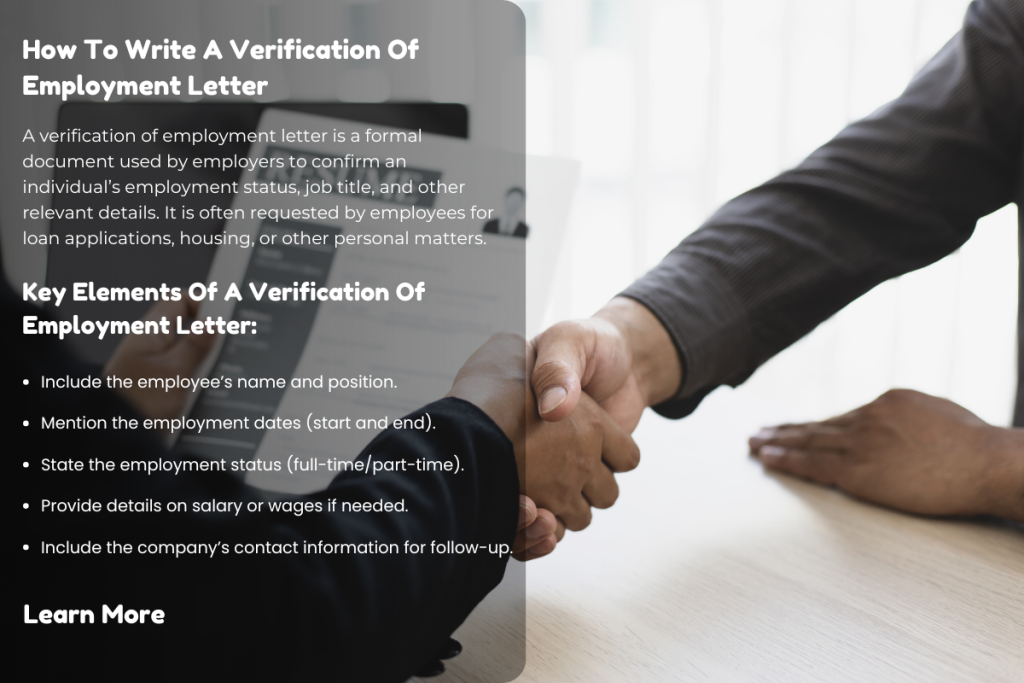
What Is a Verification of Employment Letter?
A Verification of Employment (VOE) letter is a formal document issued by an employer that confirms the employment status of an individual. The purpose of this letter is to provide third parties with reliable, official confirmation that an individual is currently employed or has previously worked for a specific employer. Typically, the verification includes key details such as the employee’s job title, dates of employment, and salary or hourly wage.
This letter is an essential document in many situations where an individual’s employment status needs to be verified. It can serve as a critical tool in situations like rental applications, loan approvals, background checks, and immigration matters. By confirming that a person has been employed or is still employed with a specific organization, the VOE letter helps provide assurance regarding the individual’s financial stability and reliability.
Why Employers Need to Write a Verification of Employment Letter
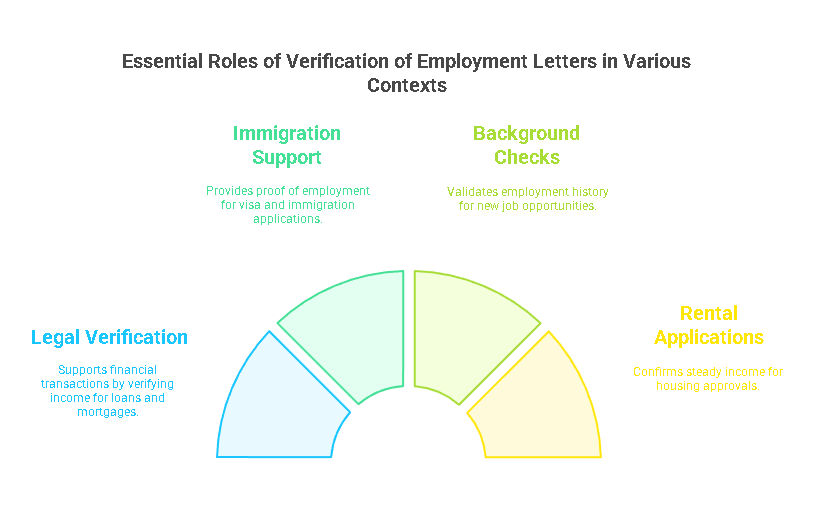
Employers are often required to write a Verification of Employment (VOE) letter for various reasons, including to support the employee’s financial or legal matters. Here’s why it’s essential for employers to understand the significance of this document:
1. Legal and Financial Verification
Employers may be asked to provide a VOE letter during financial transactions, such as loan applications or mortgage approvals. Banks and lending institutions typically require the employer to verify income to ensure the borrower can meet repayment terms. This is especially true when employees are applying for a loan, mortgage, or any financial assistance where their income plays a significant role in the decision-making process.
2. Support for Immigration or Visa Applications
Employees who are applying for immigration purposes, such as a work visa, may need to present a verification letter as proof of their current or past employment. This document helps authorities confirm that the employee meets the qualifications for the visa or immigration status.
3. Background Checks and Employment Opportunities
A background check is another common reason an employer might need to provide a verification letter. If an employee is seeking new job opportunities, their potential employer may ask for a VOE letter as part of the hiring process. This helps validate the accuracy of the resume and background information provided by the applicant.
4. Rental or Housing Applications
Landlords and property management companies often request a VOE letter when evaluating rental applications. The letter provides assurance that the applicant has a steady source of income to meet the rent requirements. Additionally, it provides an official confirmation of employment status, which is essential in making housing decisions.
Employers also may have a legal responsibility to provide accurate employment verification when requested. Inaccurate or incomplete information could expose the employer to potential legal risks, especially if the verification is used in important decisions, such as loan approvals or immigration processing.
Essential Components of a Verification of Employment Letter
A Verification of Employment (VOE) letter should include several key elements to ensure that it provides the necessary details for verification while maintaining professionalism. Here are the essential components that should be included:
1. Employee’s Full Name
The letter should begin with the employee’s full legal name. This is crucial for identification and ensures there are no misunderstandings or confusion about the person being verified.
2. Job Title/Position
This section confirms the position held by the employee at the time of the verification. Employers should clearly state the employee’s job title to avoid ambiguity. If the employee holds multiple titles or has held different positions during their employment, these should be mentioned as well.
3. Employment Start Date and End Date (If Applicable)
The start date of employment should always be mentioned, as this helps verify the duration of the individual’s employment. If the employee is no longer employed, the end date should be included. For current employees, simply stating that they are “currently employed” suffices.
4. Job Duties/Responsibilities
This is an optional but useful section. It can provide further context about the employee’s role within the organization. Providing a summary of the main responsibilities can be important, especially if the verification letter is used for a new job opportunity or financial purposes.
5. Salary or Wage Information (If Required)
Including salary or wage information is often essential when the VOE letter is used for financial purposes (e.g., loans or mortgages). Employers should clearly state the employee’s salary (whether annual, monthly, or hourly) and any other compensation, such as bonuses, if requested. However, this information should only be included if relevant or requested by the third party.
6. Employer’s Contact Information
The letter should include the employer’s contact information, such as the company’s name, address, phone number, and email address. This ensures that the third party can reach out for any follow-up verification if necessary.
7. Tone and Structure
The tone of the letter should always remain formal, and the structure should be clear and concise. A professional and courteous tone helps maintain a positive image of the organization while fulfilling the legal requirements for employment verification.
How to Write a Verification of Employment Letter
A Verification of Employment (VOE) letter is a critical document requested by various third parties to confirm an employee’s work status, salary, and other employment details. It is essential for employers and HR professionals to understand how to properly write this letter, ensuring that it is accurate, professional, and legally compliant. This section provides an in-depth, step-by-step guide on how to write a verification of employment letter, common challenges, and how Precisehire can support your organization with reliable employment verification services.
Step-by-Step Guide to Writing a Verification of Employment Letter
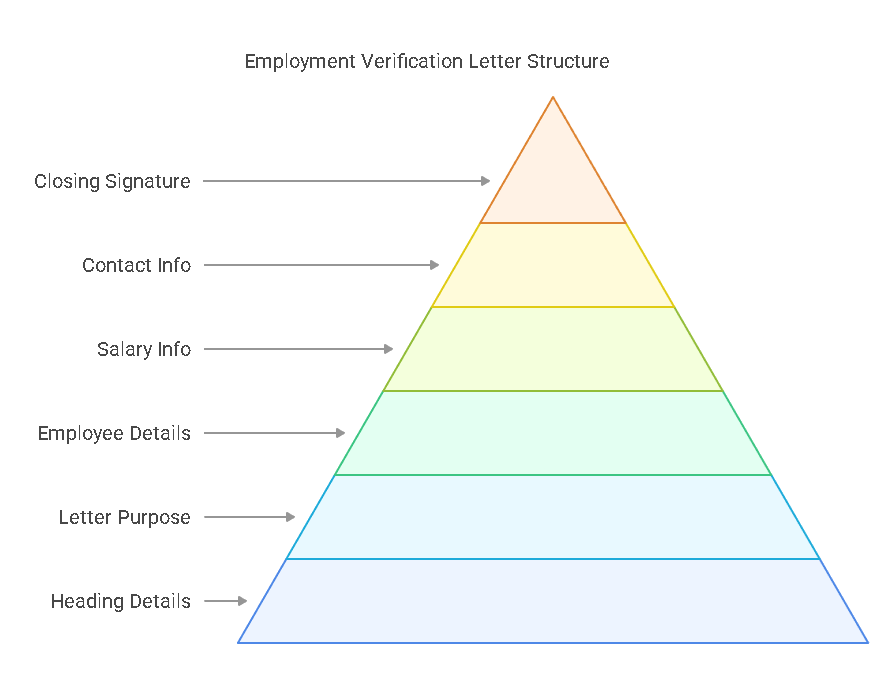
Writing a Verification of Employment letter is a straightforward process when you follow a well-structured approach. It is essential to ensure that the letter meets all the requirements of the requesting party, provides accurate information, and maintains professionalism. Below is a step-by-step guide to writing an effective employment verification letter.
Step 1: Heading and Contact Details
The first section of the letter includes the heading, which sets the tone for the rest of the document. This section should contain the following:
- Employer’s Name and Address: This establishes the company as the entity providing the verification and gives the reader context about the letter’s origin.
- Date: This is the date on which the letter is being issued.
- Recipient’s Information: If the letter is being sent directly to a third party (e.g., a bank, landlord, or another employer), include the recipient’s name, title, and contact details if available.
It is essential to ensure that the information in this section is accurate and up to date to prevent confusion.
Step 2: Introduction and Purpose of the Letter
After the heading, the next step is to state the purpose of the letter. In this section, clearly introduce the employee whose information is being verified and state the reason for the verification. Common reasons for a verification letter include mortgage applications, rental agreements, and background checks for new job opportunities.
A typical introduction might read: “This letter serves as a formal verification of employment for [Employee’s Full Name], who has requested confirmation of employment for the purpose of [state the reason: loan processing, rental application, etc.]. Below are the details of [Employee’s Full Name]’s employment with [Company Name].”
Step 3: Verifying the Employee’s Details
This is the core of the verification letter. The following details are typically included:
- Employee’s Full Name: The employee’s legal name as per company records.
- Job Title/Position: State the current job title or position the employee holds within the company. If the employee has held multiple positions, list the most recent one.
- Employment Start Date: Include the date the employee began working at your company. If the employee is no longer employed, provide the end date.
- Work Status: Indicate whether the employee works full-time, part-time, or temporarily, based on the company’s records.
- Job Duties/Responsibilities: Provide a brief description of the employee’s main duties, especially if the recipient requires this for job verification purposes.
Example: “[Employee’s Full Name] has been employed at [Company Name] since [Start Date] and holds the position of [Job Title]. [He/She/They] work full-time in the [Department Name] and is responsible for [mention key responsibilities or a brief overview of the role].”
Step 4: Salary or Wage Information (If Applicable)
Many verification letters require salary information, especially for situations such as loan applications or rental agreements. Only provide salary details when requested by the recipient. You may also need to confirm whether the employee is paid on an hourly, weekly, or monthly basis.
Example: “[Employee’s Full Name] currently earns an annual salary of [$X] or an hourly wage of [$X] as per the company’s records. [He/She/They] are paid [on a weekly/bi-weekly/monthly] basis.”
If salary details are not requested, it’s perfectly fine to leave this section out of the letter.
Step 5: Contact Information for Follow-Up
After providing the employment details, offer your contact information for any follow-up inquiries. The recipient may have additional questions, so providing clear contact details can expedite the process.
For example: “If you require further information or clarification, please do not hesitate to contact me directly at [Phone Number] or via email at [Email Address].”
Step 6: Closing the Letter and Signature
Finally, close the letter in a professional manner. Include your name, position, and contact details. Then, sign the letter to authenticate it. The signature should be of someone with the authority to verify employment information, such as an HR representative or a manager.
Example closing: “Sincerely, [Your Full Name]
[Your Job Title]
[Company Name]
[Phone Number]
[Email Address]”
A Sample Verification of Employment Letter Template
Below is a simplified template for a verification of employment letter that incorporates all the key components discussed:
| Section | Content |
|---|---|
| Header | Employer’s Name, Address, Date, Recipient’s Information |
| Introduction | This letter serves as a formal verification of employment for [Employee’s Name], for [reason]. |
| Employee Details | Name: [Employee’s Name], Position: [Job Title], Employment Start Date: [Start Date], Work Status: [Full-time/Part-time/Temporary], Key Responsibilities: [Brief Description] |
| Salary Information | Salary: [Salary or Hourly Rate], Pay Frequency: [Weekly/Bi-weekly/Monthly] (only if required) |
| Contact Details | For follow-up inquiries, contact [Your Name] at [Phone Number] or [Email Address] |
| Closing | Sincerely, [Your Name], [Job Title], [Company Name], [Contact Information] |
Common Mistakes to Avoid When Writing a Verification of Employment Letter
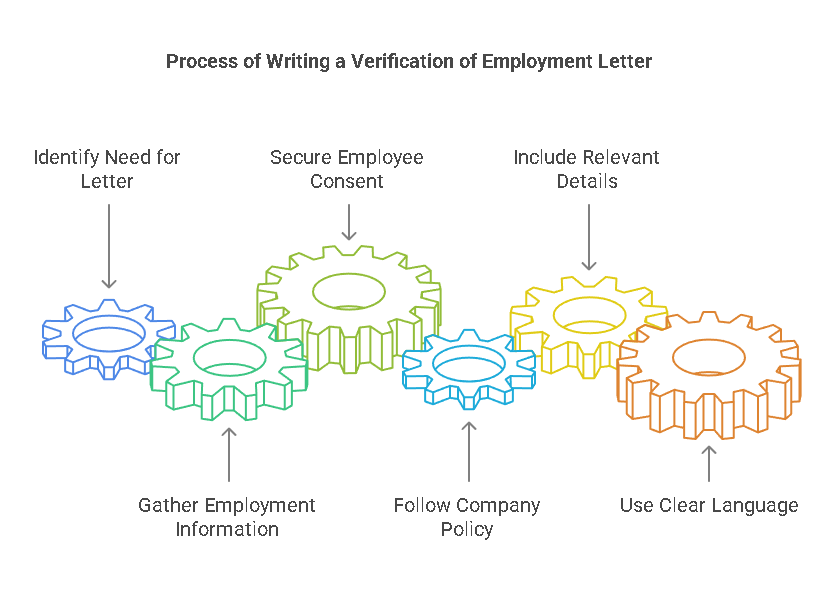
While writing a verification of employment letter is generally straightforward, there are a few common mistakes that employers should be mindful of:
- Inaccurate Information: Always double-check the accuracy of the information before sending the letter. Mistakes in dates, job titles, or salary details could cause significant problems for the employee and your company.
- Failure to Secure Employee Consent: If required by law, ensure that the employee has consented to the verification request before sharing any personal details.
- Failure to Follow Company Policy: Some companies have specific guidelines for how employment verifications should be handled. Always check with your HR department for internal policies to avoid overlooking critical steps.
- Omitting Relevant Details: If a specific third party requests certain details (e.g., salary, job duties), ensure those are included. Conversely, do not include unnecessary details if they are not requested.
- Vague or Ambiguous Language: Be as clear and specific as possible to avoid any misinterpretation of the information being provided.
The Role of Precisehire in Employment Verification
For businesses that handle high volumes of employee verifications or those that require accurate and compliant background checks, Precisehire offers a comprehensive and reliable service. Precisehire specializes in employment verification and background screening, ensuring that the verification process is both efficient and legally compliant.
Why Use Precisehire for Employment Verification?
Precisehire can provide substantial support in ensuring that employment verifications are handled quickly, accurately, and without any errors. Here are some of the key benefits of working with Precisehire for employment verification:
- Accuracy: Precisehire helps ensure the correctness of the details in the verification letter by providing accurate information from official sources.
- Efficiency: Precisehire speeds up the verification process, especially when dealing with multiple requests or high volumes of verifications.
- Legal Compliance: By partnering with Precisehire, employers can be confident that their verification processes comply with local, state, and federal regulations. This is particularly important when handling sensitive employee data.
- Streamlined Workflow: By outsourcing employment verifications to Precisehire, HR professionals and employers can save valuable time that would otherwise be spent handling these requests in-house. This allows HR teams to focus on more strategic tasks.
Legal Aspects, FAQs, and Conclusion
Our guide on how to write a Verification of Employment letter, we will explore the legal aspects surrounding the creation of such letters, address frequently asked questions (FAQs), and summarize the key takeaways. It’s essential for employers to understand the legal implications of providing an employment verification letter, especially regarding privacy, liability, and compliance with various laws. Additionally, we will discuss how businesses can protect themselves legally when issuing verification letters.
Legal Aspects of Writing a Verification of Employment Letter
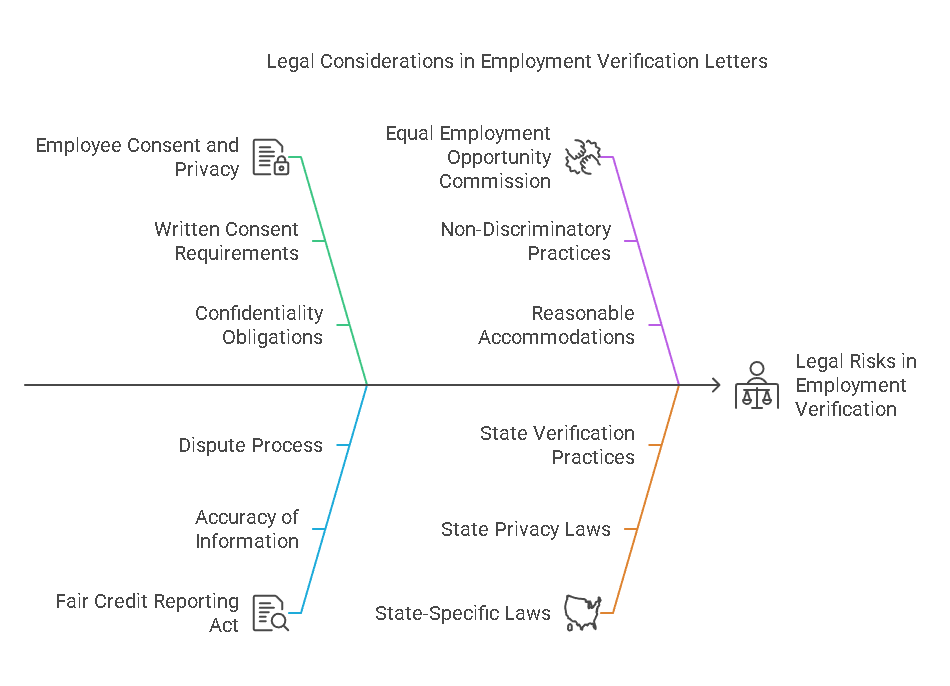
When employers write a verification of employment letter, they must comply with various legal standards, including those related to data privacy and non-discriminatory practices. Below are key legal aspects employers should consider when writing or providing employment verification letters:
1. Employee Consent and Privacy
One of the most important legal considerations when issuing an employment verification letter is obtaining the employee’s consent. While employers are not always legally required to obtain consent to verify employment, it is best practice and, in some cases, necessary.
- Written Consent: Many jurisdictions require employers to obtain written consent from employees before disclosing personal employment details, particularly sensitive information such as salary or medical status. In some cases, the requesting party (such as a bank or prospective employer) may also require the employee’s consent in writing before releasing this information.
- Confidentiality: Employment verification letters must comply with data protection and privacy laws. Information such as salary, job duties, or personal identification should only be shared with authorized parties and for legitimate purposes. Any violation of confidentiality could lead to significant legal consequences.
2. The Fair Credit Reporting Act (FCRA)
The Fair Credit Reporting Act (FCRA) is a key piece of legislation that governs the use of consumer information, including employment background checks and verifications. The FCRA mandates that employers provide accurate information when requested for employment verification and background checks. Under the FCRA:
- Accurate Information: Employers are required to provide accurate and truthful employment verification when the employee has consented. Providing false or misleading information can lead to legal liability for the employer.
- Dispute Process: Employees have the right to dispute any inaccuracies in their employment records, including those found in verification letters. If an error is found, the employer may need to correct it in writing and ensure the recipient of the verification letter is informed of the correction.
- Privacy Protection: The FCRA also regulates how personal information is disclosed, ensuring that sensitive details are only shared for legitimate purposes and with appropriate consent.
3. The Equal Employment Opportunity Commission (EEOC)
The EEOC enforces federal laws prohibiting employment discrimination. When issuing a verification of employment letter, employers should ensure that the information provided does not inadvertently discriminate against employees or applicants based on race, gender, age, religion, or disability.
- Non-Discriminatory Practices: Employers must ensure that they provide consistent and equal treatment in all employment verification letters. For example, an employer cannot share employment details in a way that implies any discriminatory intent, such as highlighting a disability or marital status.
- Reasonable Accommodation: In some cases, employees with disabilities may request reasonable accommodations during the employment verification process. Employers should work with the employee to provide the necessary support without violating their rights under the Americans with Disabilities Act (ADA).
4. Legal Liability for False Information
Providing inaccurate or misleading information in an employment verification letter can result in significant legal consequences for the employer, including:
- Liability for Fraud: If the information provided in a verification letter is found to be fraudulent, the employer could face legal action, including claims for damages and reputational harm. Employers must always be diligent when providing sensitive information about current or former employees.
- Defamation: If a verification letter includes false statements that harm the reputation of the employee, the employee could potentially file a defamation claim against the employer. To avoid this, employers must always ensure that the content of the verification letter is accurate and based on factual information.
5. State-Specific Laws
In addition to federal regulations, employers must also be aware of state-specific laws governing employment verifications. Different states have varying laws regarding privacy, data protection, and what can be disclosed about an employee.
- State Privacy Laws: Employers should ensure that their practices comply with state-level privacy laws. For instance, California has strict privacy laws regarding the sharing of personal data, which would include employment verification details.
- State Verification Practices: Some states may have unique rules about how verification letters must be structured or the types of information that can be legally disclosed. Employers must familiarize themselves with the specific rules in their state to ensure compliance.
Frequently Asked Questions (FAQs)
Do Employers Have to Provide a Verification of Employment Letter?
While employers are not always legally obligated to provide a verification of employment letter, they are typically required to do so when requested by a third party (such as a lender, landlord, or government agency), provided the employee consents. However, employers are generally under no obligation to create or issue a letter unless it is explicitly requested.
What Information Can Be Included in a Verification of Employment Letter?
A verification of employment letter typically includes the following information:
- Employee's full name
- Job title/position
- Employment dates (start and end dates, if applicable)
- Salary or wage information (if required)
- Job duties or responsibilities (if requested)
Employers should only include the information that is required by the requesting party and ensure that all data is accurate and relevant.
How Long Does It Take to Write a Verification of Employment Letter?
Writing a verification of employment letter is typically a quick process, especially if the necessary information is readily available. Most letters can be completed in under an hour, but it may take longer if the employer needs to consult with HR records or if the employee’s work history is complex.
Is There a Template for a Verification of Employment Letter?
Yes, there are many templates available online for writing a verification of employment letter. However, it’s important for employers to adapt these templates to reflect the specific needs of the employee and the requesting party. Templates should be customized to include the correct details and to comply with any legal or company-specific guidelines.
Can an Employee Request a Verification of Employment Letter from Their Employer?
Yes, employees have the right to request a verification of employment letter from their employer. Employees may need this letter for various reasons, such as applying for a loan, renting an apartment, or seeking a new job. While an employer is not obligated to issue a verification letter, it is considered standard practice and is often in the best interest of both the employee and employer.
Conclusion
In conclusion, the Verification of Employment letter is an essential document for many employment-related transactions. Employers must carefully consider legal requirements, company policies, and the accuracy of the information provided in these letters. By following best practices, employers can avoid legal pitfalls, ensure that employees’ privacy rights are protected, and maintain a smooth and transparent verification process.
For employers and businesses that need assistance with accurate, legally compliant employment verification, Precisehire offers expert services to ensure that all employment checks are handled efficiently and without error. Precisehire’s services streamline the verification process, providing peace of mind and helping companies avoid common legal and compliance mistakes.
Whether you are an HR professional, an employee, or a third party requesting verification, understanding the critical components of a verification of employment letter is key. By following the advice and guidelines provided in this article, you can ensure that the verification process remains smooth, professional, and legally compliant.
